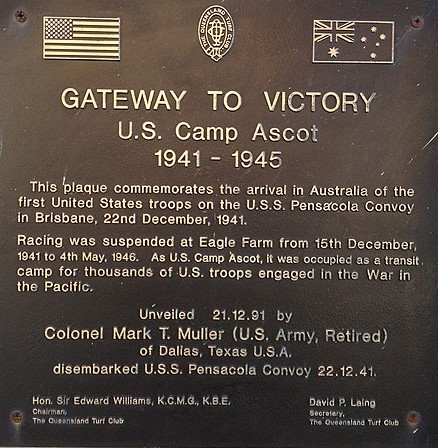The Pensacola Convoy, officially designated Task Force South Pacific, was a significant U.S. military operation during the early days of World War II. Originally en route to reinforce U.S. bases in the Philippines, the convoy was redirected to Australia following the Japanese attack on Pearl Harbor on 7 December 1941.
The convoy departed Pearl Harbor on 29 November 1941, comprising several vessels, including the heavy cruiser USS Pensacola, which served as the escort ship. After learning of the attack on Pearl Harbor, the convoy was ordered to divert to Brisbane, Australia. It arrived at Brisbane’s outer harbor, Moreton Bay, on 22 December 1941, escorted by Australian and New Zealand warships. Source: Army History Museum
Upon arrival, the convoy disembarked approximately 4,600 personnel, marking the first presence of U.S. troops on Australian soil during the war. The soldiers were accommodated at Ascot Racecourse (later known as Eagle Farm) in tents while awaiting further instructions.
The arrival of the Pensacola Convoy was met with enthusiasm by the Australian public, as it signified the beginning of a strong military alliance between the United States and Australia during a time when Japanese forces were perceived as a direct threat to the region.
In recognition of this historic event, Pensacola Convoy Place was established to commemorate the vessels and personnel of the convoy. A plaque at the site honours their arrival in the Brisbane River on 22 December 1941 and acknowledges the convoy’s role in diverting to Australia following the attacks in the Asia-Pacific region. See also: Monument Australia
The Pensacola Convoy’s timely arrival in Brisbane, just days after the attack on Pearl Harbor, played a crucial role in establishing Australia as a strategic base for Allied operations in the Pacific theatre during World War II.

The Dutch ship Bloemfontein was part of the Pensacola Convoy.
See also: Richard Casey instrumental in selecting Brisbane as a key WWII base.
Abstract: The Pensacola Convoy and the Early U.S. Military Deployment to Australia, 1941–1942
In late 1941, the Pensacola Convoy—comprising American and Allied ships including USS Republic, USAT Holbrook, and the Dutch ship Bloemfontein—departed San Francisco en route to the Pacific amid rising tensions. Following the Japanese attack on Pearl Harbor (December 7, 1941), the convoy diverted southward, eventually reaching Suva and then Brisbane, Australia.
Under the leadership of Brigadier General Julian F. Barnes, U.S. Army Forces in Australia (USAFIA) were formed, initially headquartered at Brisbane’s Lennons Hotel and later relocating to Melbourne. The convoy carried vital military personnel, aircraft, and supplies intended to reinforce the Philippines but were redirected due to rapidly deteriorating conditions in the Pacific theater.
Throughout late December 1941 and early 1942, USAFIA coordinated the unloading and assembly of aircraft, troop quartering, and the establishment of new operational bases across Australia, including Darwin, Townsville, and Adelaide. Specialised units, including artillery brigades, air squadrons, chemical warfare companies, and ordnance detachments, were distributed to strengthen Australia’s defense and prepare for further operations.
As the war expanded, leadership transitioned to Major General George H. Brett, and General Douglas MacArthur established Supreme Command of the Southwest Pacific Area (SWPA) by April 1942, integrating U.S. forces into a broader Allied structure. Strategic objectives shifted toward building Australia as a primary base for offensive operations against Japanese forces, with the Netherlands East Indies (NEI) serving as an advanced outpost.
This period marked the critical establishment of U.S. logistical and military infrastructure in Australia, setting the stage for major Allied operations in the Pacific War.
With thanks to Peter Dunn’s “Australia @ War” at www.ozatwar.com
